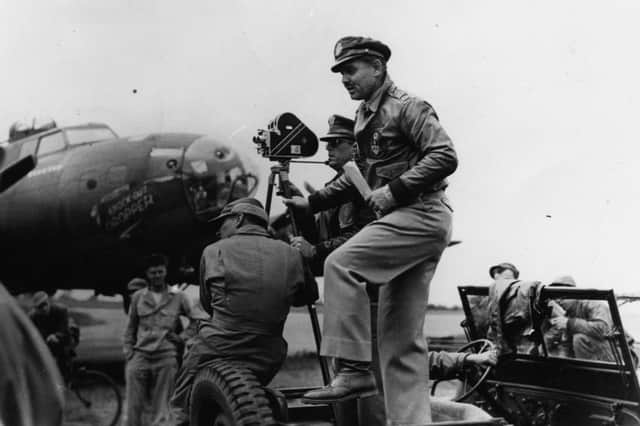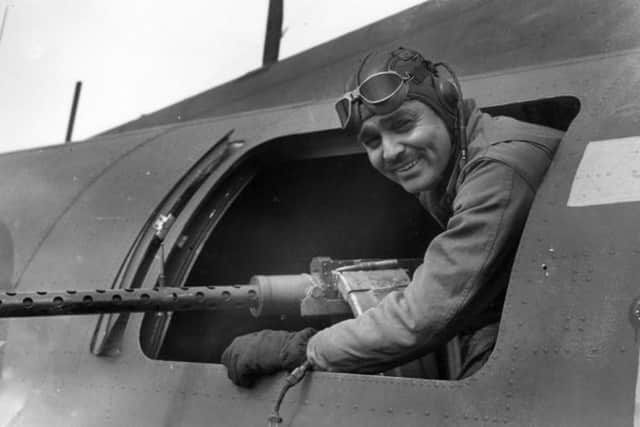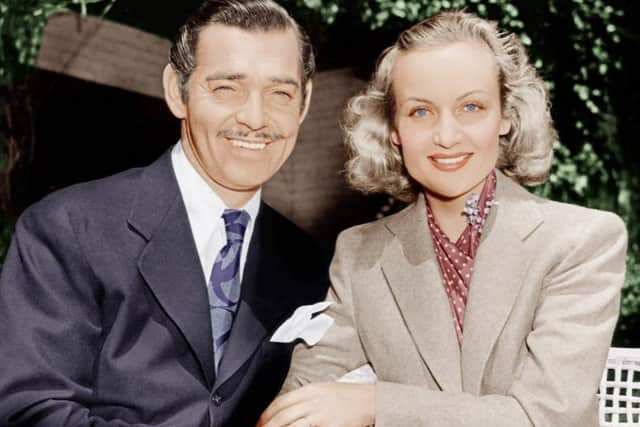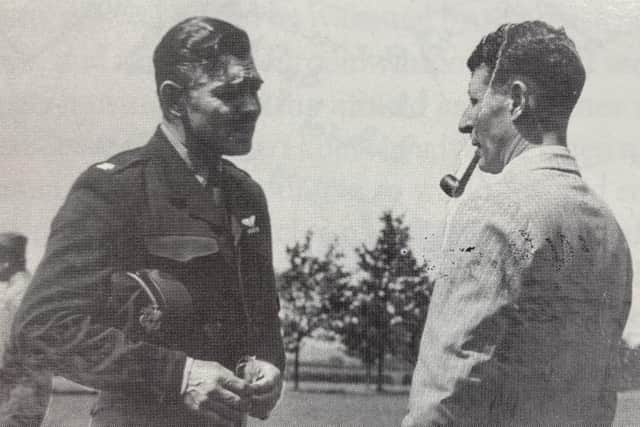When Hollywood's biggest star came to Northamptonshire


Nowadays, the chances of spotting Tom Hanks or Renee Zellweger in a quiet Northamptonshire village seem slim. But in 1943 rumours began to swirl that one of the world's biggest movie stars had been seen about a tiny hamlet in the East of the county.
Here, history teacher Mike Murray who is based at Lodge Park Academy in Corby, tells the incredible story of how Hollywood royalty ended up being based in our county at the height of his fame.
Advertisement
Hide AdAdvertisement
Hide AdThe two decades from 1930 to 1950 have become known as the Golden Age of Hollywood when the biggest stars became the idols of cinema goers and fans eagerly scanned the film magazines for news of their private lives.


There was no star who shone brighter than the socalled King of Hollywood Clark Gable. So for the residents of the sleepy village of Polebrook near Oundle, it must have been a real shock when rumours started to circulate that the American superstar had been spotted around the area.
However fanciful the idea must have seemed, the rumours were true. The 351st Bomb Group of the United States Army Air Force arrived at an airfield close to Polebrook in May 1943 to join the rapidly expanding Anglo-American force that was attacking Germany by night and day. Among the several thousand American personnel deployed to the airfield was Captain Clark Gable.
William Clark Gable was born in Ohio in 1901 and travelled to Hollywood in the mid 1920s to seek work as an actor. He starred in several silent movies and supporting roles in films before landing his first lead role in Dance, Fools, Dance opposite Joan Crawford in 1931. The following year he starred with Jean Harlow in Red Dust a film which made him MGM’s biggest male star. He won the Oscar for best actor in 1934 for his part in the film It Happened One Night.
Advertisement
Hide AdAdvertisement
Hide AdSuccess after success followed as Gable cemented his place as Hollywood’s leading star. He made three films with his friend and drinking buddy Spencer Tracy which further raised both actors’ profiles with the public.


Gable is best known for his portrayal of Rhett Butler in Gone with the Wind – one of the biggest blockbusters of all time. He was reluctant to take the role of Butler at first. The film’s producer David O. Selznick originally offered the role to Gary Cooper who turned it down. On hearing that Gable had been persuaded to take the part, Cooper reportedly said "Gone with the Wind is going to be the biggest flop in Hollywood history. I'm glad it'll be Clark Gable who's falling flat on his nose, not me."
The film was anything but a flop. It was nominated for thirteen Oscars of which it won an unprecedented eight awards and Gable’s performance was widely praised. Butler's last line in Gone with the Wind, "Frankly, my dear, I don't give a damn", is one of the most famous lines in movie history and cemented Gable’s place in Hollywood history.
Gable was married five times. His first marriage, to his agent Josephine Dillon, lasted from 1924 to 1930. Their divorce was finalised in April 1930 and Gable married his second wife, socialite Maria Langham, days later. Gable's relationship with his third wife, actress Carole Lombard, was one of the happiest periods of his personal life. They met while filming 1932's No Man of Her Own, when Lombard was still married to actor William Powell.
Advertisement
Hide AdAdvertisement
Hide AdGable and Lombard’s romance did not take off until 1936, after they became re-acquainted at a party. They were soon inseparable, with fan magazines and tabloids citing them as an official couple. Gable thrived on being around Lombard's youthful, charming, and frank personality, once stating: "You can trust that little screwball with your life or your hopes or your weaknesses, and she wouldn't even know how to think about letting you down."


Gable was still legally married, having prolonged an expensive divorce from his second wife until his salary from Gone with the Wind enabled him to reach a divorce settlement with her on 7th March, 1939. On 29th March, during a production break on Gone with the Wind, Gable and Lombard were married in Kingman, Arizona.
Less than three years after their marriage America was rocked by the Japanese attack on Pearl Harbour. Many Hollywood stars rushed to join the war effort. Some like James Stewart signed up for active service while others took part in war bond drives and tours of the factories making war supplies. Gable was keen to do his part.
Carole Lombard sent a telegram to President Roosevelt on behalf of Gable expressing his interest in active duty, but FDR thought the 41-year-old actor could best serve by taking patriotic roles in movies and helping bond drives along with his wife. On 16th January, 1942, Lombard was a passenger on Transcontinental and Western Air Flight 3 with her mother and press agent Otto Winkler. She had just finished her 57th movie, To Be or Not to Be, and was on her way home from a successful war bond selling tour when the flight's DC-3 airliner crashed into Potosi Mountain near Las Vegas, Nevada, killing all 22 passengers aboard.
Advertisement
Hide AdAdvertisement
Hide AdGable flew to the crash site to claim the bodies of his wife, mother-inlaw, and Winkler, who had been the best man at Gable and Lombard's wedding. Lombard was declared to be the first war-related American female casualty of World War II, and Gable received a personal note of condolence from President Roosevelt.
Gable remarried twice but, according to actress Esther Williams, “he was never the same. He had been devastated by Carole's death.” On 12th August, 1942, following Lombard's death and completion of the film Somewhere I'll Find You, Gable joined the United States Army as part of the Army Air Forces. MGM had been reluctant to let their star actor go but the Commanding General of the U.S. Army Air Forces Hap Arnold offered Gable a special assignment with the First Motion Picture Unit which he accepted.
Gable was off to war. MGM arranged for his studio friend, the cinematographer Andrew McIntyre, to enlist with him and accompany him through training. Later that month, Gable and McIntyre were sent to Miami Beach, Florida to undertake Officer training, which they completed on October 28, 1942, and were commissioned as second lieutenants.
His class of some 2,600 students selected Gable as its graduation speaker. After presenting the cadets with their commissions, General Arnold told Gable of his special assignment: to make a film in combat with the Eighth Air Force to recruit aerial gunners. Gable and McIntyre were immediately sent to Flexible Gunnery School at Tyndall Field, Florida, followed by a photography course at Fort George Wright, Washington State and promoted to first lieutenants upon completion.
Advertisement
Hide AdAdvertisement
Hide AdNewly-promoted Gable was assigned to the 351st Bombardment Group. The Group trained at Biggs Army Air Base, Texas, and Pueblo Army Air Base in Colorado before heading to the UK in April 1943 where it was based at Polebrook airfield. Gable's first combat mission occurred on 4th May 1943 when he and 351st group commander Lt. Col. William A. Hatcher, flew with the 303rd Bomb Group based at nearby Molesworth airfield to attack targets in Antwerp.
The mission was uneventful apart from Gable suffering a minor case of frostbite on one of his hands from the intense cold at the high altitude. Soon after this the 351st Bomb Group became operational and started to fly missions of its own. It would be July before Gable flew his second mission. On 10th July 1943 The Group unsuccessfully attempted to bomb an airfield at Villacoublay in France. There was too much cloud to see the target clearly and rather than risk missing the target and hitting nearby villages the aircraft returned with their bombs.
A later mission on August 12 would be the toughest one he took part in. Flying as part of 351st Operations Officer Major Theodore "Ross" Milton and Captain John B. Carraway's crew, the target was a synthetic oil plant at Gelsenkirchen in the Ruhr Valley. Due to bad weather the aircraft instead bombed nearby Bochum, as a target of opportunity.
Of the 330 American aircraft dispatched on this mission, 25 were shot down and many others were badly damaged. Although none of the 351st Bomb Group’s aircraft were shot down, 11 suffered battle damage, one crash-landed on return, and the group's crews suffered one killed and seven wounded. Gable’s aircraft was one of the many damaged by German fighter attacks.
Advertisement
Hide AdAdvertisement
Hide AdOn return to Polebrook the crew counted 15 holes in the plane and Gable himself had an incredible escape. A German 20mm cannon shell burst through the flight deck and tore the heel from one of his flying boots before exiting the aircraft less than 30cms from his head. The shell failed to explode, had it done so then Gable would surely have been killed.
Talking with reporters after the mission Gable brushed off their concerns claiming, "I didn't know it had happened. I didn't know anything about it until we had dropped eleven thousand feet and could get off oxygen and look around. Only then did I see the hole in the turret."
Gable was reportedly Adolf Hitler’s favourite actor, and he offered a sizable reward to anyone who could capture and bring Gable to him unscathed. Having completed five missions Gable was taken off combat missions and started putting together the footage needed for his film. Hitler’s reward went unclaimed.
While based at Polebrook, Gable became a familiar face to locals. When not on duty he would often tour local villages on his motorbike. He frequented several of the local pubs and was happy to sign autographs for any locals who summoned the courage to ask for one.
Advertisement
Hide AdAdvertisement
Hide AdOundle resident Lorna Sloan recalled meeting the actor. “We were sitting on the terrace minding our own business and we heard a car roll up. We peeped around the corner and saw Clark getting out of the car,” she said.
“We shot back and sat down as though nothing had happened at all. Around the corner came Clark with all his buddies, the scriptwriter and the photographer from Gone with the Wind.” After going back to Polebrook for a few hours to check on the safe return of a mission, Clark returned to the house with quite a party, including Major Richardson, Colonel Burns and some of the nurses from the American hospital at Lilford.
“There was a shortage of booze in those days, so we took Clark along to The George Pub on the corner. We had a great big enamel jug and went to fill it up – and poor old Mrs Marriott who kept the pub opened the hatch, saw Clark Gable there and nearly passed out.”
Gable was awarded the Air Medal on 4th October for completing five combat missions, and later the Distinguished Flying Cross.
Advertisement
Hide AdAdvertisement
Hide AdOn November 5, Gable left Polebrook to return to the USA. He took with him over 50,000ft of 16mm colour film taken in the preceding months. In June 1944, Gable was promoted to Major. While he hoped for another combat assignment, he had been placed on inactive duty and on June 12, 1944, his discharge papers were signed by Captain Ronald Reagan, also a well-known film actor, who would later become the US President.
Gable completed editing of the film Combat America in September 1944, giving the narration himself and making use of numerous interviews with enlisted gunners as the focus of the film.
Although the film was intended to be used as a recruiting film for aerial gunners, by the time it began production the need for gunners had lessened so it was completed as an account of aerial combat over occupied Europe and as a testament to the Eighth Air Force aircrew and ground crew in England. Gable returned to Hollywood but never quite regained the glory of his prewar roles.
His last film “The Misfits” was also co-star Marilyn Monroe’s final big screen appearance. Gable died, aged 59, of a heart attack on 16th November 1960. Clark Gable will be best remembered for his portrayal of Rhett Butler in Gone With The Wind and his delivery of its immortal last line. But, at the height of his fame, he chose perhaps his greatest role when he volunteered for active service in war-torn Europe and risked his life to help defeat fascism.
You can read more about our county's rich history in the Lodge Park Local History Group's regular newsletters, online here.